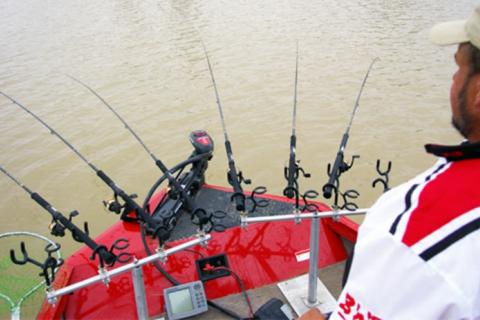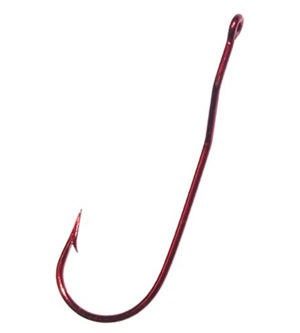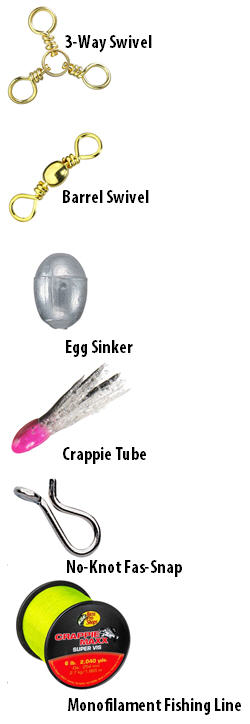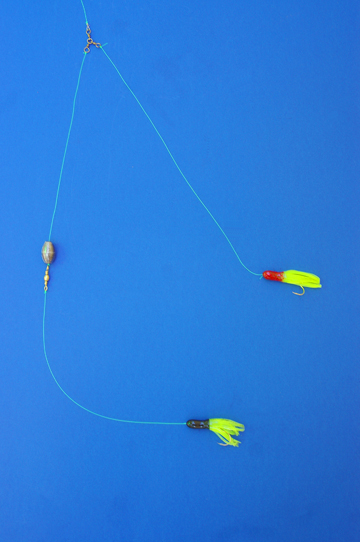
| Once you see it done, it's easy to tell where spider rigging gets its name. |
Spider rigging, or spider trolling as it is often called, is a tactic that should be part of every crappie angler's arsenal. The name originates from the use of multiple poles jutting from the front, back and/or sides of the boat, which gives the craft the appearance of a colossal spider with legs pointing in all directions. Few methods are better suited for finding often-scattered schools of crappie.
Spider rigging may involve the use of as few as two fishing poles or as many as 16, but six to eight are most commonly used. The poles — long, graphite or graphite-composite trolling or jigging poles, or sometimes cane poles — are held in rod holders. Some anglers still use C-clamp rod holders that can be screwed down tight on the boat's gunwales wherever the angler wants them. In more recent years; however, manufacturers have begun offering high-quality "T-bar" fishing rod holders that won't slip off or twist to the side like the old C-clamps.
 |
| Driftmaster T-Bars Spider Rigging Rod Holders |
These have two to eight rod holders attached to a crossbar, and each crossbar is on an upright that has a bottom bracket for securing the T-bar in the boat. When properly placed, these T-bar rod holders allow the angler to fish with several poles spread out at regular intervals across the front, back and/or sides of the boat, usually a foot or two apart. Rigged this way, the angler can drift with the wind or troll with an electric motor and sweep a broad area of water with a variety of baits to find crappie.
The number of poles used when spider rigging depends to a large extent on the ability of the angler. The fewer the number of poles, the simpler the fishing. As the number of poles increases, it becomes more difficult to keep lines and baits from tangling and to hook and land fish, especially when there are multiple bites. As with so many things, practice makes perfect.
Determine beforehand if there are any restrictions on the body of water you'll be fishing. On some lakes, you can fish with as many poles as you dare to; elsewhere, the number is limited.
Spider Rigging Basics
Most spider riggers start by using a variety of baits or lures rigged at different depths. For example, when using six poles, four might be rigged with fishing jigs in different colors and sizes, and the other two with minnows. Two baits might be set 6 feet deep, two at 8, and two at 10. This allows testing different baits and depths until you find actively feeding crappie. When you determine crappie favor a certain depth or bait, then all the poles are rigged to conform to that preference.
| T-bar rod holders make it easy to arrange poles. |
Almost any fishing bait or lure that entices crappie can be used. Jigs and live minnows are the choice of most anglers, but crankbaits, spinners, spoons and other crappie-catchers may be used as well.
Anglers with big boats sometimes mount one or two pedestal boat seats on the front deck just behind the T-bar rod holders. This allows the angler to sit comfortably within reach of the poles while fishing. A sonar fishfinder also can be mounted here to aid in following bottom channels and other crappie-attracting structure while trolling.
Some anglers prefer to push their rigs, with all poles at the front of the boat. Some prefer to pull them, with all the rigs at the stern. Some do both at once, and may include poles along the boat's sides as well. All these variations work well. The one you use will depend to a large extent on how proficient you become at spider rigging and how many anglers your boat will accommodate. When rigs are spread around the front, sides and back, you'll need a fishermen near each spread to land crappie that are hooked. A single angler in a small johnboat may be able to accomplish this with no trouble. In bigger crafts where several anglers are fishing, you may prefer having poles at all points of the compass.
 |
| Minn Kota Endura Max Transom-Mount Trolling Motors |
If the wind is blowing, you can get by without a trolling motor, but you're not likely to catch as many crappie. Wind drifting is a one-way, time-consuming affair: make a drift, take up the lines, motor back up, reset the lines, drift again. A trolling motor allows constant fishing without fuss. It also permits you to vary your speed and control direction — important factors when chasing fussy crappie.
The Fishing Right Rig
 |
| Mr. Crappie Wally Marshall Crappie Fishing Hooks |
There are many different rigs you can use on your spider-rig poles. One of the simplest is made by attaching a 1-ounce bank sinker to the end of your main line. Above this are two to four 12- to 18-inch-long drop lines (shorter lines on top, longer on bottom) spaced about 18 inches apart. Each drop line is connected to the main line via a loop knot or swivel. Jigs or 1/0 to 2/0 Aberdeen crappie fishing hooks are tied to the drop lines. If hooks are used, they are baited with live minnows. If you like, you can tip jigs with minnows as well, for extra enticement. The finished rigs are lowered to the bottom, then you just start trolling.
While this rig works ok, a much better one (but also a bit more complicated) is a double-lure rig I learned from Arkansas crappie pros Chris Mullins and Ricky Lucius. It works great year-round in an amazing variety of conditions.
"We use this rig spring, summer, fall and winter to catch crappie up to 3 pounds and more," Mullins said. "By adjusting the size of the sinker, and the size and length of the lines, it can be used under almost any fishing conditions imaginable, from a calm day spent fishing shallow water to a windy day trolling over deep-water cover and structure."
 To make the rig, you need the following fishing tackle components: one three-way swivel, one barrel swivel, one egg sinker (1/4 to 3/4 ounce — lighter for calm days or shallow trolling; heavier for windy days or deeper trolling), two 1/0 crappie hooks, two crappie tubes, one No-Knot Fas-Snap, and some 4-, 6- or 8-pound-test monofilament line like Crappie Maxx Super Vis fishing line (lighter in clearer water, heavier in muddy water).
To make the rig, you need the following fishing tackle components: one three-way swivel, one barrel swivel, one egg sinker (1/4 to 3/4 ounce — lighter for calm days or shallow trolling; heavier for windy days or deeper trolling), two 1/0 crappie hooks, two crappie tubes, one No-Knot Fas-Snap, and some 4-, 6- or 8-pound-test monofilament line like Crappie Maxx Super Vis fishing line (lighter in clearer water, heavier in muddy water).
To the bottom eye of the three-way swivel, tie an 18-inch mono leader. Run this through the egg sinker, then tie the tag end to the barrel swivel. To the other eye of the barrel swivel, tie a 15-inch leader to which one of the crappie hooks is tied. Tie the other crappie hook to a 12-inch leader, and tie this leader to the side eye of the three-way swivel. Rig the crappie tubes on each hook so the hook eye is inside the tube. Use different color tubes until you determine a pattern.
 |
| A rig used by crappie pros Chris Mullins and Ricky Lucious, which can be used year-round. |
The Fas-Snap, tied to the main line, facilitates quick change-out of rigs made with different size hardware for different fishing conditions. Snap the remaining eye of the three-way swivel to the Fas-Snap and you're ready to fish.
Mullins and Lucius fish these rigs on 12, 14 or 16-foot B'n'M Capps & Coleman Series trolling rods, using up to eight poles at once where permitted. The poles are placed in rod holders on Driftmaster T-Bars, the rigs are lowered near the bottom and the duo slow trolls around stumps and other cover. When fishing shallower water, the lines between the three-way swivel and the bottom hook are shortened appropriately.
Trolling Speed for Spider Rigging
Speed probably is the most important aspect of spider rigging, but there's no magic formula for determining what speed is best under a given set of conditions. On some days you may have to inch your boat along to get strikes. On other days you must troll much faster to catch fish. And when you find the productive speed, you must maintain it, even when wind or current push your boat ahead or drive it back.
A good starting point is about 1.5 to 2 mph, but savvy anglers experiment with different trolling speeds until they determine what is most effective. This varies with the type of bait used and the measure of water clarity. For example, you might troll minnows or small spinners very slowly for crappie in a lake muddied by heavy rain. Crappie feed primarily by sight. In discolored water they may have a difficult time pinpointing a tiny, fast-moving jig but have little trouble homing in on a shiner or flashy spinnerbait slowly passing by.
In a clear-water lake, jigs may be very effective even at faster trolling speeds. Then again, they may not produce at all. The key word here is experiment. Try to figure how crappie are likely to react in the type of water you're fishing, then adapt your tactics to conform to those expectations. But if your game plan doesn't produce within a short time, try something different. Sooner or later, the innovative crappie angler discovers a pattern for capitalizing on the situation.
One mistake crappie anglers often make is trolling at the same boat speed when headed into the wind as when headed with the wind. On an otherwise still lake, you travel faster with the wind than against it, assuming you never reposition your electric motor throttle. Therefore, in order to maintain your ideal trolling speed, you must adjust the throttle up or down depending on which way you are traveling.
These factors may explain why you catch crappie when trolling in one direction and not in the other.
Starting the Troll & Finding the Crappie
Some anglers start their troll blind; they have no idea what type of structure or cover is beneath the water. They simply start trolling and hope their hit-and-miss tactics produce more hits than misses.
| Arkansas crappe pros Chris Mullins (left) and Ricky Lucious (right) have used spider rigging to win or place in many national and regional crappie tournaments. |
It's best, however, to use fish finders to pinpoint structure and cover crappie favor — woody cover along the edges of creek and river channels, long points, rock piles rising into lighted water, man-made fish attractors, etc. — and troll over that. With a serious look at a bottom contour map and a quick check of prominent bottom changes with sonar, you could be catching slabs in minutes instead of wandering aimlessly.
Try zigzagging over channel breaks and adjacent flats. Stump fields and weed edges at proper depths may be good early and late when crappie are more likely to be feeding. In summer, crappie are likely to be strung out along the thermocline in a shallow plane, so covering large areas of water by trolling may enable you to catch more of these fish within a given range.
When you find schooling crappie, throw out a marker buoy so you can anchor just outside the school and cast to it, or continue to troll around the concentration. A savvy angler may take crappie from one of these marked spots for an hour or more, so long as the fish aren't spooked.
Crappie aren't hard to catch, but at times they're hard to find. Spider rigging, done properly, can help you overcome that problem. Practice this method and you'll rarely need to stop by the fish market on the way home.
- 51409 views

